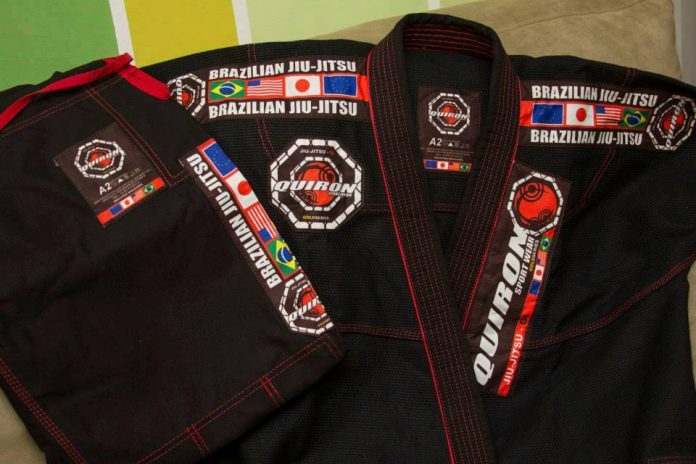
One of the defining characteristics of Jiu-Jitsu is the BJJ Gi. While Kimonos are used in a number of different martial arts, the BJJ Gis are definitely different. In the early days of the sport, competitors started putting patches on their Gis to make them stand out. The Gis back then were Judo style Gis which, along with this customization, gave birth to the modernBJ jGi. From there on, certain modifications were made until the finished product we all wear today emerged. Nowadays there are different types of BJJ Gis that you can get, and they’re not all best suited for any occasion.
While I’m a No-Gi guy myself, I definitely train in the Gi. A lot. Throughout the years. I’ve figured out my Gi preferences and now I know where I stand – the lighter the Gi, the better. However, this realization didn’t just come to be. I spent a lot of time experimenting with different types of BJJ Gis. I’ve tried different colors, different weaves, and materials, different cuts and uses. The fact remains, you’re going to need more than one BJJ Gi, and you will need at least a couple of different types if you’re going to train Jiu-Jitsu full time.
What Are You Looking For In A Gi?
BJJ Gis have certain requirements that they have to fulfill. One main thing is longevity. BJJ Gis does not always come cheap, meaning that you can’t just buy another one every couple of months. That said, a Jiu-Jitsu kimono will definitely have to be able to take some abuse. In just about every moment on the mats, a Gi gets pulled, tucked, twisted, etc. This goes on and on as you train, so it is no wonder that sturdiness and resilience area main gi properties. The Gi weave, and, to a certain extent, the material, play the key roles in this department.
Apart from a long life, the next aspect of a BJJ Gi should be intended for use. Training is easy – you can go about it in any Gi out there if academy rules permit it. However, competition is different and if you are also a competitor, you’ll have considered that when you’re choosing your Gi. Three are certain color, style, cut, etc, limitations when it comes to Gis that are acceptable in tournaments. Of course, this is not the case in every competition, but in most of them, run by the major promotions, there’s no way around it.

The Common Types OF BJJ Gis
By types of BJJ Gis, I do not mean the Gi designs per se. In terms of design, we can go on and on, as there are hundreds of different variations out there. Instead, types refer to the material, cut, style and purpose of GIs. And the one characteristic that plays the most important role is the Gi weave.
The weave refers to the way in which the Gi fibers align to form the Gi. In most cases, this mostly refers to the Gi jackets, as pants mostly come in a rip-stop version. The weave determines the strength, and in many cases, the weight of the Gi. The general options, in order of strength, are single weave, pearl weave (the most common), gold weave and double weave. Ther are also some modern and new weave,s like the diamond, etc, but they don’t seem to offer many new properties.
The weave also determines how heavy a Gi is, which is measured in ‘Grams per square meter” or GSM. The usual range is between 375 and 890 GSM. There are, of course, lighter and heavier Gis at the appropriate ends of this spectrum.
Training Gis
Not many of you would start competing without some actual training, so this is the first category of BJJ Gis we’ll talk about. In training, the most important thing is that you’re comfortable. You’ll spend most of your time training, so you need a multi-purpose Gi for that, particularly if you’re just beginning with the competition. A training Gi should be long-lasting, tough, and fit you snugly. Apart from that, you can go in whichever way you want in terms of color or GI design, as long as that’s all right in your academy. A single or pearl weave Gi is the way to go here, or even a lightweight one if you’d like to really go for comfort.
Beginners Kimonos
As a beginner, you’ll most likely come in completely confused when it comes to buying your first Gi. While the resident Gi geek in the gym will most certainly be able to help you, you can also keep things simple. Go with a single weave and rip-stop pants and you’ll do just fine. Moreover, these types of BJJ Gis are usually the cheapest, so if you decide the sport is not for you, at least it won’t cost you a fortune. The downside is that these Gis are not the best when it comes to how long they’ll last. Stitching can also be dodgy, but for a first Gi, it’ll do just fine. It may even serve in your first couple of tournaments as well.
Oh, and if you’re unsure of the color, just go with a white Gi. You can always upgrade later on.
Competition Gis
This is where you’ll really need to be careful with your choices. A competition Gi is something you can wear for training, but in most cases, dedicated competition Gis only comes out when it’s time to put your BJJ to the test.
First up, know the Gi requirements of the tournament(s) you’re competing in. That usually means you’re down to blue, black or white color. In terms of designs, how much weight you cut will certainly influence how heavy a Gi you choose. Weigh-ins take place with the Gi on, be mindful of that. The weave is huge here, nut just for weight but also for an advantage. If your Gi is hard to hold, you’ll have an easy time dealing with grips. A pearl or gold weave is the way to go here and make sure the cut fits your body type. The better the fit, the better the performance.
Don’t expect a good competitor Gi to come cheap, though. It will last longer and most likely be of exceptional quality, plus you can wear it for training as well.
Lightweight
A lightweight Gi is not for everyone. If you’re like the standard pearl weaves and heavier BJJ Gis., you’ll probably feel strange in one. At first. These weigh less than the usual Gis and take up less space.
Lightweight Gis are usually 1005 cotton and feature lighter, simpler weaves. As expected they score sky-high on comfort and performance but do not last as long as heavier Gis. Competition-wise, you can wear one, but you might find it hard to stir grips off. Plus, competing in a lightweight Gi just means you’ll have it tear quicker. Perfect for training, though, particularly in hot weather conditions. Dries quicker than heavier BJJ Gis as well.
Backup Gis
This is where you can have fun with different types of BJJ Gis. If you already have your training, competition and perhaps even travel Gis sorted out, you can look into a backup GI. Once again, if it is a backup Gi for both training and competition, choices are limited due to rules and performance requirements.
However, in most cases, a backup Gi is just one more Gi that you’re going to use sparingly. My take on this is to experiment. You can go to the extremes here, given that you already have enough Gi types for specific occasions. Plus, you can train in any type of Gi out there. Extra-heavy double weaves, diamond weaves, extremely lightweight Gis, crazy designs – they all fit in this category.
Travel Gis

Unusual BJJ Gis
Finally, a bit of fun. These types of BJJ Gis come in all possible designs, but they also often feature crazy material. Premium Gis, custom Gis, some limited editions Gis all feature here. I guess they could go into the backup gi category, but they’re only for training. They’re mostly gis you show off in, and they’re often really really expensive. Wil last nearly a lifetime, though, as most of them are ultra-high quality.
How Many Gis Do You Need?
The question every Gi grappler gets asked on a daily basis. It is also a question that has no real answer, although everyone would most likely like to answer with “more”. In all seriousness, consider hygiene first when you’re trying to figure out the ideal number of Gis. Even if you’re a beginner, training more than three times a week means you need at least two Gis. And yes, you need to wash your Gi after each and every training session.
In terms of tactical preparation, a couple of training Gis (different colors), a competition Gi and a travel gi are the bare minima. I’d throw in a backup Gi in there as well. That’s five right there, which is not a cheap thing to accomplish. This combination of different types of BJJ Gis, though, will have you ready for just about anything from training in your academy, to rolling on an open mat at some summer resort you decide to visit.
Final Words
If you train with the Gi, you’ll end up collecting Gis. Knowing what you need will make the selection process easier. Once you have all the minimum required types of Gis, you can go and have fun. Widen your collection to include everything you’re interested in giving a try. After all, there are new designs and even types of Gis coming out every week! Make sure you check out our best BJJ Gi section to find the gi that suits you.


![Darce Choke Encyclopedia – Origins, Mechanics and Variations [2024] BJJ, choke, Brabo, BJJ Darce Choke, D'arce Choke, Darce BJJ Choke](https://bjj-world.com/wp-content/uploads/2017/11/JungPoirierLeeYahoo-218x150.jpg)









![Front Head Lock Kaynan Duarte DVD Review [2025] Front Head Lock Kaynan Duarte DVD Review](https://bjj-world.com/wp-content/uploads/2025/02/front-head-lock-kaynan-duarte-dvd-review-218x150.png)
![Baby Shark Guard System Diogo Reis DVD Review [2025] Baby Shark Guard System Diogo Reis DVD Review](https://bjj-world.com/wp-content/uploads/2025/02/baby-shark-guard-system-diogo-reis-dvd-review-218x150.png)
![Master The Move Anaconda Strangle John Danaher DVD Review [2025] Master The Move Anaconda Strangle John Danaher DVD Review](https://bjj-world.com/wp-content/uploads/2025/02/anaconda-strangle-john-danaher-dvd-review-218x150.png)

![Baseball Chokes From Everywhere Magid Hage DVD Review [2025] Baseball Chokes From Everywhere Magid Hage DVD Review](https://bjj-world.com/wp-content/uploads/2025/01/baseball-chokes-from-everywhere-magid-hage-dvd-review-218x150.png)
![Essential Shin To Shin System Shawn Williams DVD Review [2025] Essential Shin To Shin System Shawn Williams DVD Review](https://bjj-world.com/wp-content/uploads/2025/01/shin-to-shin-system-shawn-williams-dvd-review-218x150.png)
![Feet Finder Foot Sweeps Christian Ozbek DVD Review [2024] Feet Finder Foot Sweeps Christian Ozbek DVD Review](https://bjj-world.com/wp-content/uploads/2024/09/feet-finder-foot-sweeps-christian-ozbek-dvd-review-324x235.png)
![Advanced Immortal Clinch Matt Brown DVD Review [2024] Advanced Immortal Clinch Matt Brown DVD Review](https://bjj-world.com/wp-content/uploads/2024/09/advanced-immortal-clinch-matt-brown-dvd-review-100x70.png)



![Reverse Arm Bar System Andrew Kerfoot DVD Review [2024] Reverse Arm Bar System Andrew Kerfoot DVD Review](https://bjj-world.com/wp-content/uploads/2024/10/reverse-arm-bar-system-andrew-kerfoot-dvd-review-100x70.png)
![Mastering Takedown Prevention Steve Mocco DVD Review [2024] Mastering Takedown Prevention Steve Mocco DVD Review](https://bjj-world.com/wp-content/uploads/2024/11/mastering-takedown-prevention-steve-mocco-dvd-review-100x70.png)


![Dima Murovanni Kill The Collar Tie BJJ Trendsetters DVD Review [2024] Dima Murovanni Kill The Collar Tie BJJ Trendsetters DVD Review](https://bjj-world.com/wp-content/uploads/2024/09/dima-murovanni-kill-the-collar-tie-dvd-review-100x70.png)

![Kill The Underhook Dima Murovanni DVD Review [2024] Kill The Underhook Dima Murovanni DVD Review](https://bjj-world.com/wp-content/uploads/2024/10/kill-the-underhook-dima-murovanni-dvd-review-100x70.png)
![Wrestling For Jiu-Jitsu Shawn Williams DVD Review [2025] Wrestling For Jiu-Jitsu Shawn Williams DVD Review](https://bjj-world.com/wp-content/uploads/2025/01/wrestling-for-jiu-jitsu-shawn-williams-dvd-review-100x70.png)

![Foot Sweep the World Dainis Nguyen-Huu DVD Review [2024] Foot Sweep the World Dainis Nguyen-Huu DVD Review](https://bjj-world.com/wp-content/uploads/2024/11/foot-sweep-the-world-dainis-nguyen-huu-dvd-review-100x70.png)
![Double Sleeve Guard Jon Thomas BJJ DVD Review [2024] Double Sleeve Guard Jon Thomas BJJ DVD Review](https://bjj-world.com/wp-content/uploads/2024/10/double-sleeve-guard-jon-thomas-bjj-dvd-review-100x70.png)

![Wristlocks From The Top Pete Letsos DVD Review [2025] Wristlocks From The Top Pete Letsos DVD Review](https://bjj-world.com/wp-content/uploads/2025/01/wristlocks-from-the-top-pete-letsos-dvd-review-100x70.png)
![Basic Closed Guard Jasmine Rocha DVD Review [2024] Basic Closed Guard Jasmine Rocha DVD Review](https://bjj-world.com/wp-content/uploads/2024/11/basic-closed-guard-jasmine-rocha-dvd-review-100x70.png)






![Mastering The Crucifix Alexandre Pereira DVD Review [2025] Mastering The Crucifix Alexandre Pereira DVD Review](https://bjj-world.com/wp-content/uploads/2025/01/mastering-the-crucifix-alexandre-pereira-dvd-review-100x70.png)
![Shin to Shin Eoghan O’Flanagan DVD Review [2025] Shin to Shin Eoghan O'Flanagan DVD Review](https://bjj-world.com/wp-content/uploads/2024/12/shin-to-shin-eoghan-oflanagan-dvd-review-100x70.png)
